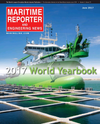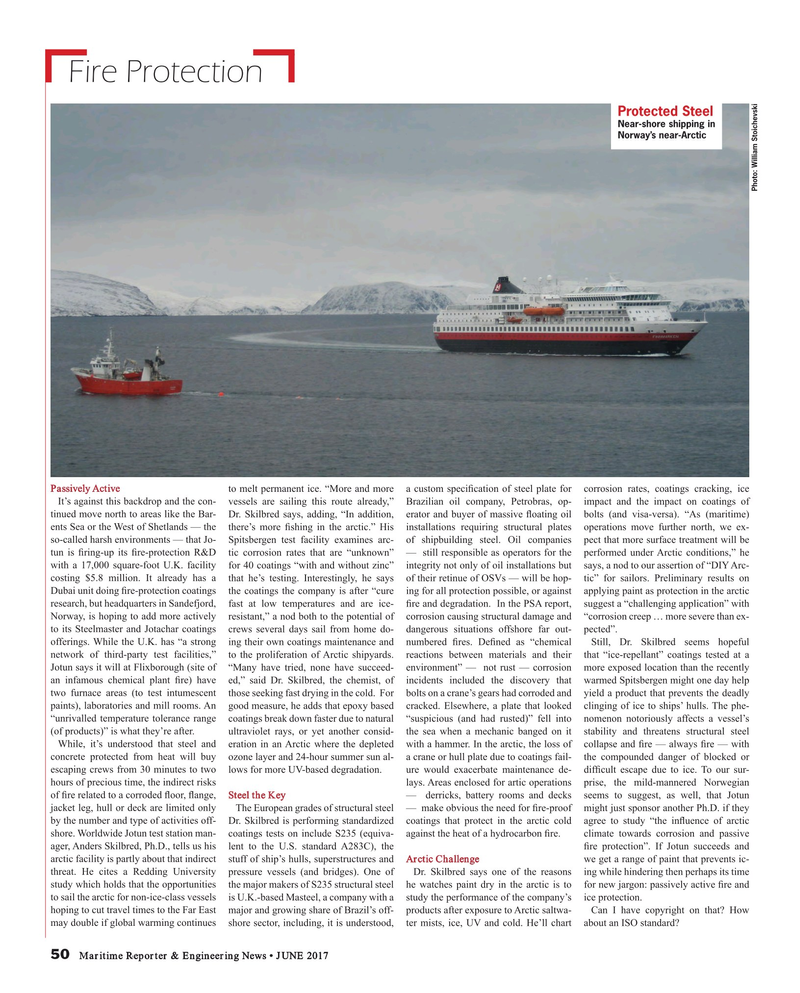
Page 50: of Maritime Reporter Magazine (June 2017)
U.S. Navy Quarterly
Read this page in Pdf, Flash or Html5 edition of June 2017 Maritime Reporter Magazine
Fire Protection
Protected Steel
Near-shore shipping in
Norway’s near-Arctic
Photo: William Stoichevski
Passively Active to melt permanent ice. “More and more a custom speci? cation of steel plate for corrosion rates, coatings cracking, ice
It’s against this backdrop and the con- vessels are sailing this route already,” Brazilian oil company, Petrobras, op- impact and the impact on coatings of tinued move north to areas like the Bar- Dr. Skilbred says, adding, “In addition, erator and buyer of massive ? oating oil bolts (and visa-versa). “As (maritime) ents Sea or the West of Shetlands — the there’s more ? shing in the arctic.” His installations requiring structural plates operations move further north, we ex- so-called harsh environments — that Jo- Spitsbergen test facility examines arc- of shipbuilding steel. Oil companies pect that more surface treatment will be tun is ? ring-up its ? re-protection R&D tic corrosion rates that are “unknown” — still responsible as operators for the performed under Arctic conditions,” he with a 17,000 square-foot U.K. facility for 40 coatings “with and without zinc” integrity not only of oil installations but says, a nod to our assertion of “DIY Arc- costing $5.8 million. It already has a that he’s testing. Interestingly, he says of their retinue of OSVs — will be hop- tic” for sailors. Preliminary results on
Dubai unit doing ? re-protection coatings the coatings the company is after “cure ing for all protection possible, or against applying paint as protection in the arctic research, but headquarters in Sandefjord, fast at low temperatures and are ice- ? re and degradation. In the PSA report, suggest a “challenging application” with
Norway, is hoping to add more actively resistant,” a nod both to the potential of corrosion causing structural damage and “corrosion creep … more severe than ex- to its Steelmaster and Jotachar coatings crews several days sail from home do- dangerous situations offshore far out- pected”. offerings. While the U.K. has “a strong ing their own coatings maintenance and numbered ? res. De? ned as “chemical Still, Dr. Skilbred seems hopeful network of third-party test facilities,” to the proliferation of Arctic shipyards. reactions between materials and their that “ice-repellant” coatings tested at a
Jotun says it will at Flixborough (site of “Many have tried, none have succeed- environment” — not rust — corrosion more exposed location than the recently an infamous chemical plant ? re) have ed,” said Dr. Skilbred, the chemist, of incidents included the discovery that warmed Spitsbergen might one day help two furnace areas (to test intumescent those seeking fast drying in the cold. For bolts on a crane’s gears had corroded and yield a product that prevents the deadly paints), laboratories and mill rooms. An good measure, he adds that epoxy based cracked. Elsewhere, a plate that looked clinging of ice to ships’ hulls. The phe- “unrivalled temperature tolerance range coatings break down faster due to natural “suspicious (and had rusted)” fell into nomenon notoriously affects a vessel’s (of products)” is what they’re after. ultraviolet rays, or yet another consid- the sea when a mechanic banged on it stability and threatens structural steel
While, it’s understood that steel and eration in an Arctic where the depleted with a hammer. In the arctic, the loss of collapse and ? re — always ? re — with concrete protected from heat will buy ozone layer and 24-hour summer sun al- a crane or hull plate due to coatings fail- the compounded danger of blocked or escaping crews from 30 minutes to two lows for more UV-based degradation. ure would exacerbate maintenance de- dif? cult escape due to ice. To our sur- hours of precious time, the indirect risks lays. Areas enclosed for artic operations prise, the mild-mannered Norwegian of ? re related to a corroded ? oor, ? ange, Steel the Key — derricks, battery rooms and decks seems to suggest, as well, that Jotun jacket leg, hull or deck are limited only The European grades of structural steel — make obvious the need for ? re-proof might just sponsor another Ph.D. if they by the number and type of activities off- Dr. Skilbred is performing standardized coatings that protect in the arctic cold agree to study “the in? uence of arctic shore. Worldwide Jotun test station man- coatings tests on include S235 (equiva- against the heat of a hydrocarbon ? re. climate towards corrosion and passive ager, Anders Skilbred, Ph.D., tells us his lent to the U.S. standard A283C), the ? re protection”. If Jotun succeeds and arctic facility is partly about that indirect stuff of ship’s hulls, superstructures and Arctic Challenge we get a range of paint that prevents ic- threat. He cites a Redding University pressure vessels (and bridges). One of Dr. Skilbred says one of the reasons ing while hindering then perhaps its time study which holds that the opportunities the major makers of S235 structural steel he watches paint dry in the arctic is to for new jargon: passively active ? re and to sail the arctic for non-ice-class vessels is U.K.-based Masteel, a company with a study the performance of the company’s ice protection.
hoping to cut travel times to the Far East major and growing share of Brazil’s off- products after exposure to Arctic saltwa- Can I have copyright on that? How may double if global warming continues shore sector, including, it is understood, ter mists, ice, UV and cold. He’ll chart about an ISO standard?
50 Maritime Reporter & Engineering News • JUNE 2017
MR #6 (50-57).indd 50 MR #6 (50-57).indd 50 6/8/2017 9:57:15 AM6/8/2017 9:57:15 AM

 49
49

 51
51
